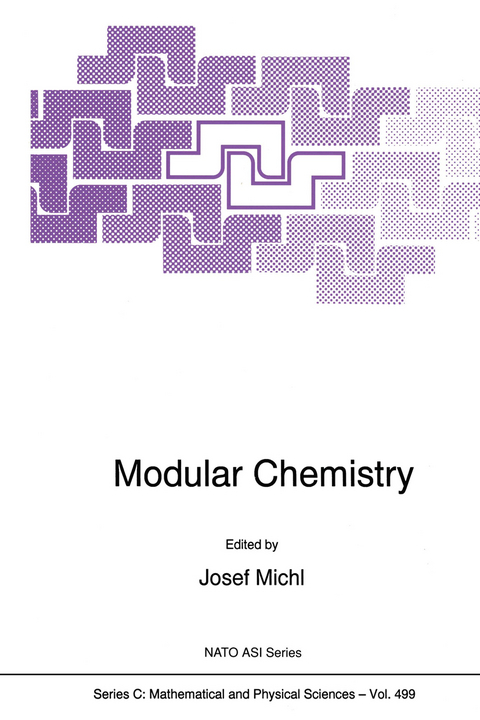
Modular Chemistry
Springer (Verlag)
978-94-010-6353-1 (ISBN)
Lectures and Discussions.- Towards Designer Solids. Tinkertoy-like Molecular Grids and Scaffolds.- Tetraethynylethenes: Versatile Carbon-Rich Building Blocks for Two-Dimensional Acetylenic Scaffolding.- Discussion of the Michl and Diederich Lectures.- Modular Assembly of Surface Heterostructures from Inorganic Clusters and Polyelectrolytes.- Photopatteming to Create New Structures on Surfaces.- Discussion of the Mallouk and Lectures.- Ag(I)?NC-R Coordination Networks.- The Control of DNA Structure. From Topological Modules to Geometrical Modules.- Discussion of the Moore and Seeman Lectures.- Wiring-Up Nanostructures.- Discussion of the Tolbert Lecture.- Supramolecular Architecture in Langmuir-Blodgett Films.- Crystal Engineering of Ionic Solids. Polymorphism, Crystallography, Inter-Ring Interactions and C—H Hydrogen Bonding.- Discussion of the Palacin and Seddon Lectures.- The Benzene Ring as Modulus: Extended Polybenzoid Disc Structures and Their Supramolecular Ordering.- Discussion of the Müllen Lecture.- Dendrimers: Nanoscopic Modules for the Construction of Higher Ordered Complexity.- Assembling Triarylmethyls into Mesoscopic-Size Polyradicals: How to Maintain Strong Interactions Between Multiple Sites in a Single Molecule?.- Discussion of the Tomalia And Rajca Lectures.- Self Assembly of Molecular Materials.- Towards Oligophenylene Cycles and Related Structures: A Repetitive Approach.- Discussion of the Stupp and Schlüter Lectures.- Graphene in 2 & 3 Dimensions.- Fullerene Footprints: Cycloadducts of Carbon Rings.- Discussion of the Ebbesen and Scuseria Lectures.- Bricks and Open-Shell Buildings in Molecular Magnetism.- Semiconductor Nanocrystals as Molecules and Building Blocks.- Discussion of the Kahn and Brus Lectures.- Hierarchical Inorganic Materials:Stealing Nature’s Best Secrets. Modular Chemistry Over Three Length Scales.- Assembly of Oriented Nanometer Channels on Organic Layers.- Discussion of the Ozin and Bein Lectures.- Design and Synthesis of Macromolecular Systems Consisting of Cyclodextrins and Polymers.- Toward Modular Chemistry with the Dendritic Box as Module.- Discussion of the Harada and Meijer Lectures.- Molecular Self-Assembly of Hydrogen-Bonded Crystalline Networks.- From Molecules to Crystals.- Discussion of the Ward and Zaworotko Lectures.- Poster Presentations.- Bottom up Construction of Photochemical Molecular Devices by Modular Chemistry.- Construction of Solid/Solid Interface Models Using Modular Chemistry: The Si/SiO2 Interface.- Synthesis of New Molecular Systems.- Multiply Ethynylated ?-Complexes of Iron, Cobalt, and Manganese: Modules for the Construction of Rigid Organometallic Objects.- Diels-Alder Oligomers of Benzene.- Single Electron Tunneling in Molecular Nanostructures of Crystalline Gold Clusters Attached by Dithiols to Au [111]: Direct I(V) Measurements of Individual Surface Attached Gold Clusters by STM.- Molecular Optical Rails Based on Aib. Modular Chemistry with Unusually Reliable Peptide Helices.- Modular Design of Multi-Porphyrin Arrays for Studies in Photosynthesis and Molecular Photonics.- Polyimide Nanofoams from Phase Separated Triblock Copolymers.- Control of the Molecular In-Plane Orientation in Langmuir-Blodgett Films by Shearing.- Rods, Rings, Balls and Strings! Structural Motifs in Carborane Chemistry.- Organization of a Non-Amphiphilic Supermolecule in Mixed Monolayers.- A Modular Approach to Large Functional Structures.- Iterative Building Block Approaches to Discrete Polystannane Oligomers.- Fullerene Tinker Toys.- New Modules — New Families of InterlockedMolecules.- Zirconocene “Molecular Zippers”: Implements for Construction of Well-Defined Polymers and Macrocycles.- Directing Nucleation and Growth of Molecular Crystals on Ordered Substrates: The Role of Epitaxial Interactions.- Nanocomposites, Molecular Composites and Their Fields of Application.- Designing Porosity in Coordination Solids.
| Reihe/Serie | NATO Science Series C ; 499 |
|---|---|
| Zusatzinfo | 127 Illustrations, black and white; XVII, 677 p. 127 illus. |
| Verlagsort | Dordrecht |
| Sprache | englisch |
| Maße | 160 x 240 mm |
| Themenwelt | Naturwissenschaften ► Chemie ► Anorganische Chemie |
| Naturwissenschaften ► Chemie ► Organische Chemie | |
| Naturwissenschaften ► Chemie ► Physikalische Chemie | |
| Technik ► Maschinenbau | |
| ISBN-10 | 94-010-6353-2 / 9401063532 |
| ISBN-13 | 978-94-010-6353-1 / 9789401063531 |
| Zustand | Neuware |
| Haben Sie eine Frage zum Produkt? |
aus dem Bereich


